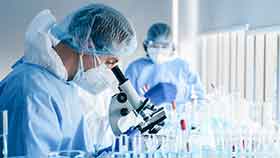 Custom Master Bond adhesive formulations are utilized by laboratory equipment manufacturers for adhering a wide variety of parts, components, apparatus, devices, and systems to meet specific requirements. These compounds replace traditional fastening techniques and help ensure reliable, precise, accurate measurements, long-term durability, and performance. They are employed globally by:
Custom Master Bond adhesive formulations are utilized by laboratory equipment manufacturers for adhering a wide variety of parts, components, apparatus, devices, and systems to meet specific requirements. These compounds replace traditional fastening techniques and help ensure reliable, precise, accurate measurements, long-term durability, and performance. They are employed globally by:
- research and development laboratories
- industrial quality control departments
- educational institutions
- medical professionals in hospitals, diagnostic centers and clinics
- forensic laboratories
- environmental testing laboratories
- governmental agencies
Some examples of key contributions obtained from laboratory equipment include:
- soil composition analysis
- separate components of biological samples
- analyze rock and mineral samples
- observe celestial objects and study the universe
- measure electrical properties
- monitor air and water quality
- medical imaging
- analyze substances found at crime scenes
- temperature measurements
- hardness testing
- tensile strength testing
- microbial growth monitoring
- measure pollution levels
- measure the intensity of light at different wavelengths
- assess the elasticity of materials
- quality control and safety testing of food/beverages
- identification and development of new medications
- sequence DNA for genetic studies
Common kinds of laboratory equipment that can be potentially constructed with Master Bond adhesives are:
- incubators
- centrifuges
- air filtration systems
- microscopes
- autoclaves and sterilizers
- scopes
- temperature controllers
- gas flow meters
- cryogenic freezers
- refrigerators
- analytic balance scales
- laboratory furniture
- distillation equipment
- shakers and stirrers
- automated liquid handling modules
- spectrophotometers
- colorimeter
- chromatographs
- power supplies
- DNA sequencers
- PCR machines
- blood analyzers
- microfluidic systems
- lab on a chip technology
- signal processing
Major advantages of adhesive bonding laboratory equipment components and parts in comparison to welding, soldering, mechanical fastening with screws, bolts, rivets etc.:
- more efficient assembly process
- weight reduction for portable or handheld lab devices
- prevent ingress of contaminants or leakage of fluids
- improved aesthetics
- faster production cycles
- join dissimilar materials including stainless steel, brass, glass, quartz, rubber, titanium, ceramic, nylon, acrylic, graphite
- reduce material wastage
- fatigue resistance
- eliminate need for machining
- contamination free assembly process
- precise bonding in miniature assembly
- vibration damping
- lower stress concentration
- design flexibility with complex configurations
Multiple grades of different Master Bond products can yield outstanding results in mating various substrates for fabricating laboratory equipment. The most significant compositions consist of:
- epoxies
- silicones
- urethane modified epoxies
- elastomeric systems
- cyanoacrylates
- UV/visible light curing systems
Master Bond is keeping pace with the ever-evolving technological advances and enhanced capabilities in fabricating laboratory equipment. Areas of considerable interest involve:
- miniaturization
- novel polymers
- sustainability
- augmenting heat dissipation characteristics of thermal conductive adhesive
- multi-module instrumentation adeptness
- helping assist devising field deployable instruments
- boost energy efficiency
- more accessible user-friendly interfaces

